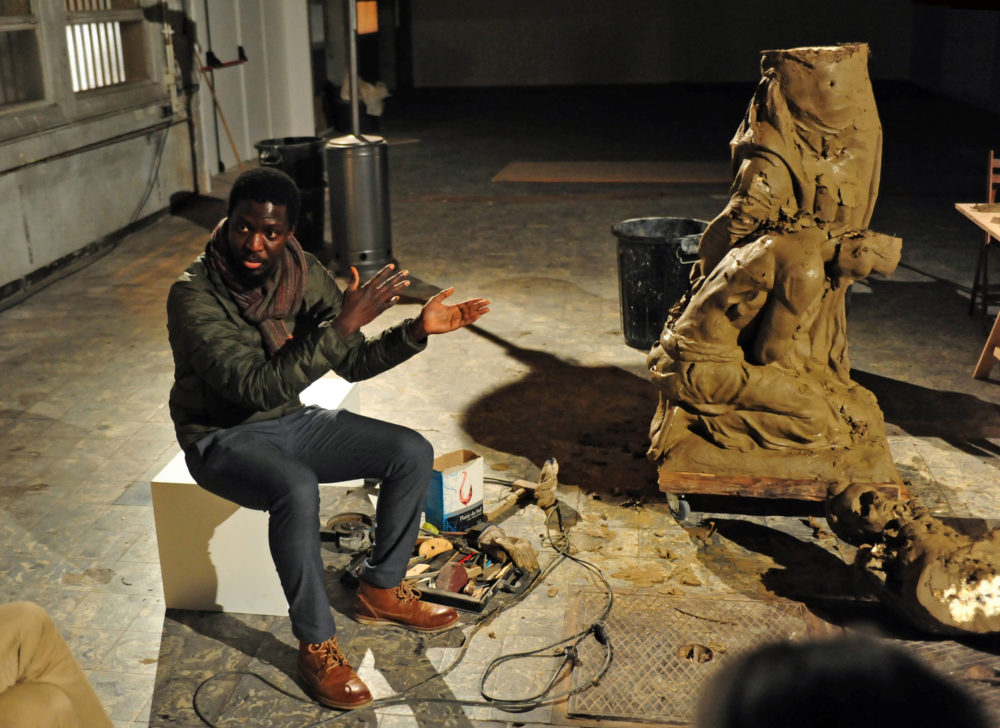
Since the tragic events that transpired in Charlottesville, South Carolina, last August, a fierce debate about what should be done with problematic monuments has been raging—and not just in the United States.
In Europe, colonial-era monuments pose a particular problem. Like monuments to the confederacy in the US, sculptures memorializing European colonizers are rarely combined with the context or counter-perspective that would allow for a nuanced interpretation of history. And similarly, the same questions are raised about what is to be done with them: Should these opressive monuments be destroyed? Relocated to a museum? Should the historical context be added? Or some sort of counter-monument built?
In Belgium, the Ghanaian artist Ibrahim Mahama is addressing these issues in his latest project, titled “On Monumental Silences,” which opened at Antwerp’s Extra City Kunsthal, on Saturday, January 27 (through March 4).
Belgium’s violent colonial past is deeply entrenched in many aspects of public life, given its long colonial rule over the Congo (an area 76 times bigger than Belgium itself) and its eight-year military occupation of Ruanda-Urundi (now the independent states of Rwanda and Burundi) in the aftermath of World War I.
View of Ibrahim Mahama’s “Silent Recreations,” ©Mark Rietveld, courtesy Extra City.
Mahama’s exhibition is based around a public intervention the artist staged earlier this month surrounding a controversial statue in Antwerp. In a discussion moderated by historian Omar Ba, titled “Silent Recreations,” Mahama manipulated a soft clay copy of a monument to colonial missionary and explorer Constant de Deken, working towards a potential future counter-monument.
“Most public monuments are cast in permanent materials like bronze, but to start with, what if it is not permanent, but subject to change within its production?” Mahama explains. He aims to confront the public with the values inherent in such monuments, and make us think about how they could be transformed for the better.
Erected in 1904, the Father de Deken sculpture is infamous in Belgium for its depiction of the European holding out a cross and standing with one of his knees on the back of a half naked African slave. In 2015, a fiery social media campaign resulted in local authorities mounting an information panel beneath the statue, but it was a marginal and easily overlooked element, which, many contend, is not enough to disrupt the dominance of the original image.
View of Ibrahim Mahama’s “Silent Recreations,” ©Mark Rietveld, courtesy Extra City.
It’s important to critically examine the function of monuments in today’s society because visual culture does shape history, and public monuments speak to what a community wants to remember. In the case of Father de Deken, the monument echoes the values of the so-called “civilizing mission,” and reinforces Belgium’s colonial power and the view of Africans as “less than.”
Video documentation of the public intervention is on view in “On Monumental Silences,” which will display a scaled-down copy of the original sculpture of de Deken, without its three-meter-tall plinth, which has been cast in rubber—a material symbolizing the European colonial empire’s extraction of resources from African countries. This faces the new version, which remains unfinished, divided into parts and still in wet clay, speaking to the need to continue challenging these types of images.
“I believe both works deal with the approach to representation and history as a material which is in constant change, which can also be reimagined within several forms or contexts,” Mahama tells artnet News.
But of course, this particular monument is just a starting point. Exhibition curator Antonia Alampi explains to artnet News that Mahama’s project is the first within a three-year research-led project examining monuments, organized by Extra City Kunsthal and the Middelheim Museum, a 30-acre sculpture park also in Antwerp. The program will reflect on the role of public monuments in order to “dissect and deconstruct the notion of citizenship we currently employ in Europe,” she says.
When asked how conversation in Europe about racist monuments has changed since Charlottesville, Alampi cites organizations that have been working on the topic in Belgium for decades, such as Mémoire Coloniale in Brussels and Hand in Hand Against Racism in Antwerp, but concedes Charlottesville played a huge role in pushing the conversation forward, saying, “I think the episode of Charlottesville really encouraged mainstream national media to finally engage more consistently with this subject.”
View of Ibrahim Mahama’s “Silent Recreations,” courtesy Extra City.
View of Ibrahim Mahama’s “Silent Recreations,” © Mark Rietveld, courtesy Extra City.
View of Ibrahim Mahama’s “Silent Recreations,” © Mark Rietveld, courtesy Extra City.